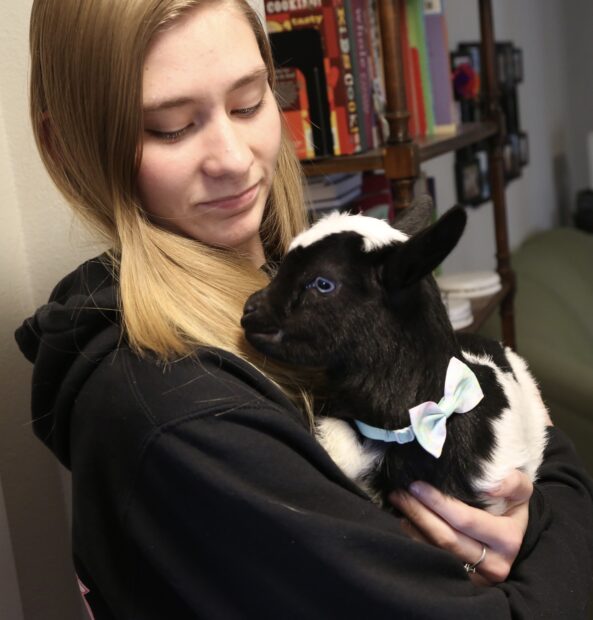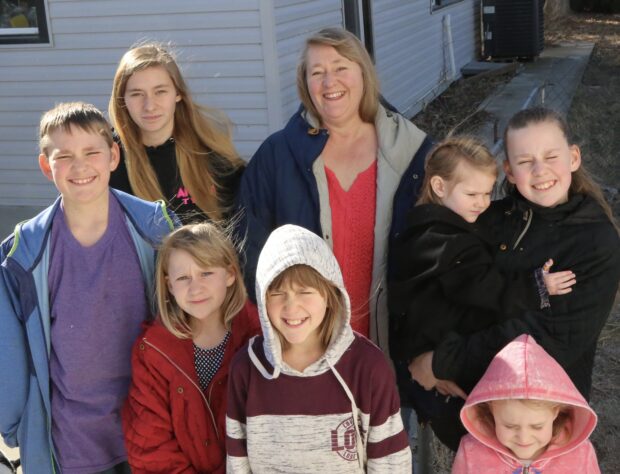This is the final story in a four-part series on how the opportunity to choose another school benefited the academic health of four Idaho families. Published Sunday: Cheyenne Anderson nearly dropped out but she found a charter school willing to help. Published Monday: Kuna’s dual language program helps students stay connected with Colombian family. Published Tuesday: 13-year-old Jonah Layton found his academic niche at college.
Open-minded and passionate about education, Heather Erwin recalled an oft-repeated joke within the homeschooling community — “everything is school.”
Indeed, even the family pets are part of lesson plans, a decision Heather may come to regret, because the list of past and present animals is growing: a goat, gecko, toad, tortoise, bunny, guinea pig, cow, tank of fish and brood of chicks — the snake only stayed around two days so he didn’t get named. Her kids are planning on pigs, horses, turkeys and ducks, too.
“You don’t get a pet unless you can do a presentation and a report,” Heather said.

She and her husband Michael homeschool 10 children: three are now adults, six are school-age and 2-year-old Zoey knows her numbers but not in order. They’re currently living on a rural property near the small town of Homedale.
While her family has a tradition of homeschooling, Heather’s reasons differ from her parents. During middle school, her mother taught her at home out of necessity while she recuperated from an illness. Eventually it became the best option.
“She could present it in a way that I understood,” remembers Heather, who has several forms of dyslexia.
For Heather and Michael, the choice to homeschool was an easy decision, despite the obvious challenges of educating so many children.
“I personally think it’s the best education. You can tailor it for each child’s learning style. And you teach (them) what they’re passionate about,” Heather explained.
Tailored curriculum
The curriculum Heather teaches fits each child’s interests and pace, which increases a desire for knowledge. “And really as parents and as teachers, our goal should be teaching them the skills it takes to learn or teach themselves, because in 12 years of school, you’re never going to teach any child everything they need to know. But if you can teach them how to learn, and how to find the information themselves, and give them the passion for having that knowledge, you can’t stop them.”
Developing citizenship
Homeschooling allows the Erwins to build strong family bonds and develop responsibility. Each child is responsible for chores like laundry and dishes, handling the household budget, and cooking. They also incorporate volunteering at nonprofits, overnight field trips, and working with co-ops, families who get together to provide their children with educational and social opportunities. Sophia volunteers at a horse farm, helping with surgeries, vaccinations, shoeing and grooming.
“I want them to be good citizens. And right now I don’t think our teens are graduating with an understanding of the significance of being a citizen,” Heather said.
Public schools
Heather disagrees with some of the methods and materials being taught in public schools, particularly in American history.
“I met a young lady who graduated high school two years ago, and she never took a government class in her life. That bothers me. You know it’s part of our history to (understand) how our nation runs. I want them to be politically involved,” Heather said.
Traditional education isn’t developing independent thinkers, which is the difference, she says, between indoctrination and education. “In my opinion … in some, I think they teach you what to think, instead of how to think.”
For the past 10 years, Heather and one or more of her children have volunteered at Legislative Day — more fondly known as “Pie Day” — at the Statehouse, an event sponsored by Homeschool Idaho. Homeschool families served legislators over a 1,000 slices of homemade pie and provided dozens of student displays this year.
“It’s a great way to introduce kids to state government,” Heather said.

Raising and educating children who are more than 20 years apart — Matthew, 24, Andrew, 23, Ethan, 18, Sophia, 16, Rebecca, 14, Joshua, 12, Emma, 10, Abigail, 8, Jasmine, 5, and Zoey, 2 — requires strategic planning and dedication to purpose.
On their education calendar, there are alternating days of co-op work in Nampa, reading, Bible study, spelling, chores, science, lunch, more reading, history for the older kids, and tutoring sessions with their grandparents, who also live with the family.
Brushing hair out of Jasmine’s eyes, and surrounded by her other six children, Heather concluded, “They are priceless.”
To learn more about the types of schools available to Idaho families, visit EdNews here.
